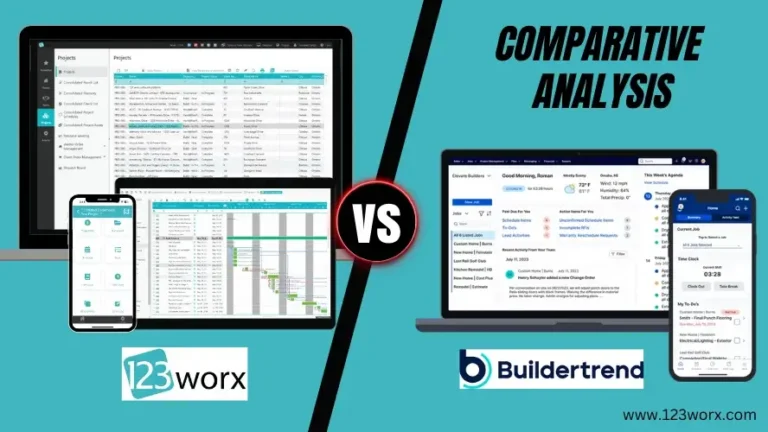In hybrid construction work environments, workers are located anywhere on job sites, in offices, and off-site. Managing schedules, resources, and subcontractors remotely is no easy feat without the right tools. For this reason, construction collaboration software is a requirement in 2025. Contractors, field workers, and project managers can stay on the same page with current information, file sharing, mobility, and centralized task lists.
A lack of a streamlined system can cause costly holdups, safety conflicts, and missed targets. In this blog post, we’ve selected and compared the 10 best construction collaboration software for construction teams who work from anywhere, highlighting their features, strengths, and ideal use cases. If you’re running minimal renewals or extensive development, these platforms will enable you to build faster, smarter, and together, anywhere.
Why Remote Collaboration in Building Requires Specialised Software?
Construction is by its nature dynamic and portable, crews are on the worksite, architects may be offsite, and clients demand updates on a real-time basis. Office-based tools, such as spreadsheets or email, often fail when dealing with a project that has numerous moving parts. Construction collaboration software delivered remotely puts all participants in a single virtual workspace, where updates, documents, and decisions are instantly available across devices and geographies.
Main advantages are:
- Mobile-optimized dashboards for field updates
- Storage of blueprints, change orders, and permits
- Real-time communication to prevent project slowness
- Centralized task lists with automated notifications
Contractors who invest in construction-specific collaboration software can cut down on communication problems and administrative workload while fostering accountability throughout all project stages.
For general and specialty trades contractors in particular who need to coordinate with teams spread out across locations, this streamlined line of communication and task management is essential.
10 Best Construction Collaboration Software Platforms in 2025
- 123worx – All-in-One Real-Time Construction Management
- Procore – Enterprise-Grade Collaboration for Large Contractors
- Buildertrend – Residential Contractor & Client Communication Hub
- Fieldwire – Field-First Coordination for Jobsite Teams
- Monday.com – Flexible Task Tracking for Remote Construction Teams
- PlanGrid (Autodesk Build) – Advanced Drawing & BIM Collaboration
- Smartsheet – Customizable Project Tracking for Tech-Savvy Teams
- CoConstruct – Collaboration for Custom Builders & Remodelers
- Bluebeam – Document-Centric Collaboration for Construction Teams
- eSUB – Subcontractor-Focused Project Collaboration
We’ve evaluated and compared the best construction collaboration software for 2025: 123worx, Procore, Buildertrend, Fieldwire, Monday.com, PlanGrid, Smartsheet, CoConstruct, Bluebeam, and eSub to help contractors, builders, and project managers work efficiently from anywhere. These tools streamline scheduling, document control, and communication, ensuring your team stays productive and connected across job sites, offices, and remote locations.
1. 123worx – All-in-One Real-Time Construction Management
Website: www.123worx.com
123worx is an all-in-one construction management software built from the ground up with real-time collaboration capabilities. It’s perfect for small to mid-sized contractors who handle a variety of teams and jobs on multiple job sites.
Why It Works:
- Visual Gantt charts for schedule collaboration
- Live file sharing and document management
- Team commenting and threads on tasks
- Available through web and smartphone platforms
Standout Features:
- Dashboards específicos
- Subcontractor work allocations
- Custom workflows for varied construction jobs
Best for: Contractors who require the integration of scheduling, file sharing, and field updates all under one system.
123worx eliminates the need to jump between platforms. From anywhere, RFIs can be uploaded, change orders can be assigned, and work completion can be monitored, providing total control and transparency to remote teams.
2. Procore – Enterprise-Grade Collaboration for Large Contractors
Website: www.procore.com
Procore is one of the industry’s leading construction software platforms, known for its robust project collaboration features that scale well for enterprise firms.
Why It Works:
- Cloud-based platform with role-specific dashboards
- Integrated drawing and spec management
- In-app markup and document collaboration
Key Features:
- Submittal tracking and RFI management
- Workflow automation and notifications
- Mobile app with offline sync functionality
Best for: Large-scale builders and commercial contractors with remote project managers and office staff.
Procore brings all communications and project information together, minimizing rework and ensuring increased responsibility. Its power lies in its ability to integrate field groups, subcontractors, and designers in real-time, no matter where they are situated.
3. Buildertrend – Residential Contractor & Client Communication Hub
Website: www.buildertrend.com
Buildertrend has easy-to-use collaboration tools specifically designed for residential contractors and remodelers. Its mobile-first platform and client portal make it perfect for getting all parties, from homeowners to site managers, up to speed.
Why It Works:
- Task scheduling with automatic updates
- Integrated communication and photo sharing
- Centralized lead and job tracking
Standout Features:
- Remote work daily journals for progress updates
- Messaging center and customer information updates
- Bid administration and budgeting
Ideal for: Small to mid-sized homebuilders and contractors who value customer cooperation.
Buildertrend facilitates back-and-forth communication. Clients can check on a project, pose questions, and make approvals without visiting the construction site.
4. Fieldwire – Field-First Coordination for Jobsite Teams
Website: www.fieldwire.com
Fieldwire is specifically designed for jobsite coordination and field crews. It’s made to put engineers, supers, and trades all on a single shared workspace.
Why It Works:
- Task lists organized by trade
- Mark up plans from the jobsite
- Offline functionalities through a mobile app
Key Features:
- Instant issue tracking and punch lists
- Photographic documentation and annotation
- Report generation automation
Best for: Teams working on-site who don’t need to use office-based tools for collaboration.
Fieldwire eliminates delays from misunderstandings. Crews can document problems, mark off completed tasks, and check blueprints right from the construction site.
5. Monday.com – Flexible Task Tracking for Remote Construction Teams
Website: www.monday.com
Monday.com is a work management platform that can be tailored for construction teams. It is not construction-oriented, but strong on remote task tracking and communication.
Why It Works:
- Visual boards for each project phase
- Automation of repetitive work
- Integrates with Slack, Gmail, and Excel
Key Features:
- Calendar and timeline views
- Role-based permissions
- Real-time file sharing
Best for: Teams seeking flexibility and easy-to-use tools for planning and remote updates.
Monday.com integrates the simplicity of a spreadsheet and the beauty of a Kanban board, ideal for juggling long lists of tasks across fragmented teams.
6. PlanGrid (Autodesk Build) – Advanced Drawing & BIM Collaboration
Website: www.construction.autodesk.com/products/plangrid
PlanGrid, under the Autodesk Build brand, offers powerful drawing management, versioning, and site-to-office communication in real-time.
Why It Works:
- Uploading drawings with auto versioning
- Field markups and photo tags
- Offline use for jobsite access
Standout Features:
- Submittals and punch list administration
- RFI workflow and approvals
- Report presentation to stakeholders
Best for: Businesses currently operating Autodesk or working with advanced plan documents.
PlanGrid closes the digital divide between paper plans and actionable tasks. Teams can maintain drawings up to date and linked together, even from the remotest jobsite.
7. Smartsheet – Customizable Project Tracking for Tech-Savvy Teams
Website: www.smartsheet.com
Smartsheet is a spreadsheet-style project management tool that construction teams can adapt to suit their workflows.
Why It Works:
- Gantt, grid, and card views
- Template gallery for project types
- Easy collaboration on files and checklists
Standout Features:
- Custom form creation for data gathering
- Automated alerts and updates
- Integration with Google Workspace
Best for: Tech-savvy groups who demand customised tools without compromise on collaboration.
Integrating timeless planning methods and modern features like mobility and automation, Smartsheet keeps construction teams on the same page.
8. CoConstruct – Collaboration for Custom Builders & Remodelers
Website: www.coconstruct.com
CoConstruct is geared toward custom home builders and remodelers who need close coordination among homeowners, tradespeople, and suppliers. It’s all-in-one software for custom home builders that ties together job management, accounting, and communication.
Why It Works:
- Client selection and authorization portal
- Integrated budgeting and invoicing
- Real-time notifications of schedules and changes
Standout Features:
- Centralized messaging for subs and clients
- Warranty and punch list tracking
- Lead management tools for new projects
Best for: Custom home builders, remodelers, and contractors that require powerful client-facing collaboration functionality.
CoConstruct reduces back-and-forth calls and emails by giving homeowners one simple portal for approvals, updates, and budgets—keeping projects running smoothly while helping to build trust.
9. Bluebeam – Document-Centric Collaboration for Construction Teams
Website: www.bluebeam.com
Bluebeam Revu is particularly good at collaboration due to its markup and sharing of document capabilities. It is built for contractors, engineers, and architects who work with large collections of drawings and specs.
Why It Works:
- Plans and drawings PDF markup software
- Echtzeit-Zusammenarbeit mit Bluebeam Studio
- Secure cloud-based file storage
Standout Features:
- Versioning of construction documents
- RFI and submittal workflows
- Punch list and issue tracking
Best for: Contractors and design teams that require accurate markup and version control between documents. Bluebeam ensures that all field workers and architects have the up-to-date and accurate project documents in real-time, thus reducing expensive miscommunication.
10. eSUB – Subcontractor-Centric Project
Website: www.esub.com
eSUB was engineered specifically for subcontractors to give them smartphone-friendly functionality for tracking labor, dealing with documents, and communicating with the general contractors.
Why It Works:
- Daily field reports and timesheets
- Change order and RFI document handling
- Mobile-first access to worksites for workers
Standout Features:
- Real-time labor productivity tracking
- Centralized Communications with General Contractors
- Storing plans and documents online
Best for: Commercial trade subcontractors that need field-to-office communication without enterprise-level software. eSUB automates subcontracting workflows to guarantee that all labor hours, change orders, and documentation are accounted for and distributed to the correct individuals in real time.
{Menahwile Read – Top Construction Software For Pool Builders}
Key Features to Look For in Construction Collaboration Tools
Consider your day-to-day workflow before making your decision. Ask:
- Can field teams access it from mobile devices?
- Does it have document control and task notifications?
- Does it integrate well with other tools currently utilized (CRM, accounting)?
- Is it scalable for future projects or users?
Increasingly, leading collaboration platforms feature automation, alerting, versioning, and offline synchronization, all critical to remote construction. The greatest tools combine might with simplicity, preventing teams from communicating, missing deadlines, and losing resources.
Overcoming Common Collaboration Challenges in Building
Despite superior software, problems can still result from collaboration. Mismatched priorities, uneven updates, and resistance to tech can disrupt virtual projects. The solution is not only selecting the correct tool, but also making it align with your team’s behaviors. Offer training, promote on-site use of mobiles, and establish defined standards for communication amongst roles.
Ensure subcontractors are a part of your digital workflow, and updates occur in real-time. When properly executed, digital collaboration fosters higher-performing, more transparent teams and better-satisfied clients.
How to Effectively Adopt Collaboration Software?
Changing over to a digital work collaboration tool takes more than registration; it takes buy-ins from all members of a team. Begin by educating your field supervisors and your project managers. Appoint champions to assist with bringing subcontractors and office workers on board.
Create templates for checklists, daily reports, and punch lists to maintain consistency.
Deploy in stages, test on one project prior to company-wide implementation. Utilize dashboards to track performance and engagement. Continually gather input and make adjustments to workflows to align them to conditions in the real world. And finally, ensure leaders are behind the cultural transformation by using the software themselves. Implemented correctly, these tools form the basis for rapid, transparent, and affordable project delivery.
Conclusion: Collaborate Smarter, Build Faster
Construction is not slowing, and neither can your team. The future of the workforce is remote, and online collaboration is the key to success. Whether it’s subcontractor management or client updates, the right software keeps everyone on the same page.
Each one of these tools on the list, from 123worx to eSub, has strengths. The choice is up to your scale of work, team size, and workflow requirements. Go future-ready for your construction work from anywhere, thanks to software that operates where your team works.
With effective implementation, collaboration software not only makes communication easier, but it also enables your teams to cut costly errors and shorten the duration of your projects. Make your work sites intelligent, your teams better connected, and your company stronger in 2025 and beyond.

As a Vice President at 123worx, Construction Management Platform, Bharat Rudra has worked with hundreds of business executives searching for best-suited software for their construction business with a wide array of requirements. Bharat takes pride in helping construction businesses solve their business and project management challenges. Feel free to reach Bharat if you have any questions. You can find him on LinkedIn or reach him at brudra@123worx.com













